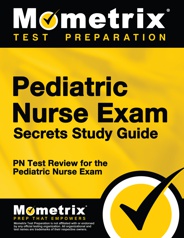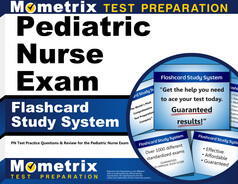The Pediatric Nursing Certification exam is designed by the American Nurses Credentialing Center (ANCC) to measure the most essential day-to-day skills and knowledge needed to excel in a career as a pediatric nurse. If you pass the exam, you will be awarded the PED-BC credential.
Click “Start Test” above to take a free Pediatric Nursing Certification practice test!
Pediatric Nursing Certification Exam Eligibility
To be eligible for the exam, you must meet all of the following requirements:
- You must have at least 2 years of full-time RN practice
- You must have at least 2,000 hours of pediatric nursing clinical practice within the last 3 years
- You must have completed at least 30 hours of continuing education in pediatric nursing within the last 3 years
Pediatric Nursing Certification Exam Outline
The Pediatric Nursing exam contains 150 multiple-choice questions, 25 of which are unscored, and you will be given a time limit of 3 hours. The unscored questions are used by ANCC to evaluate questions for future versions of the exam.
The exam is split into three content domains, and each domain contains some number of knowledge questions and skill questions:
I. Assessment and Diagnosis (43 scored questions)
The questions in this domain test your skills pertaining to physical and psychosocial assessments, diagnostic specimen collection, and medication and treatment reconciliation. You will also be tested on your knowledge of the following:
- Growth and development
- Diagnostic tests and screenings
- Pharmacology
- Assessment tools and techniques
- Pathophysiology
- Complementary therapies
- Alternative therapies
II. Planning and Implementation (37 scored questions)
The questions in this domain test your knowledge of treatment interactions, quality improvement measures, and responses to interventions. You will also be tested on your skills in the following areas:
- Formulation of realistic and measurable outcomes
- Medication administration
- Coordination of individualized care
- Evidence-based interventions
- Risk-reduction and safety measures
III. Evaluation (45 scored questions)
The questions in this domain test your skills pertaining to teaching methods, learning evaluation, and therapeutic communication techniques. You will also be tested on your knowledge of the following:
- Culture, socioeconomic status, religion, and health practices of diverse groups
- Health promotion
- Family structure and dynamics
- Chronic disease management
- Patient response to illness and hospitalization
- High-risk behaviors
- Legal and ethical considerations
Check out Mometrix's Pediatric Nurse Study Guide
Get practice questions, video tutorials, and detailed study lessons
Get Your Study Guide
Pediatric Nursing Certification Exam Registration
Registering for and scheduling your Pediatric Nursing exam can be done online. You must first submit an application, and you receive authorization to test once the application has been approved.
The cost of the examination differs depending on your membership status:
| Membership | Exam Fee |
|---|---|
| ANA member | $295 |
| SPN member | $340 |
| Non-member | $395 |
Test Day
On the day of your appointment, you should arrive at the testing center 30 minutes before the exam is scheduled to begin. When you arrive, you will be asked to provide two forms of identification, one of which must be a government-issued photo ID.
Personal items (cell phones, coats, wallets, food/drink, notes, etc.) are not allowed in the testing area. You will be asked to leave them in a secured locker before the exam begins.
Once the check-in process is complete, you will be led to your testing station and given a short tutorial on the testing system before beginning your exam.
How the Pediatric Nursing Certification Exam is Scored
The scores for this exam are calculated using a criterion-based scoring system. This means that a panel of ANCC subject-matter experts has evaluated the questions and determined a passing score. The passing score is set using the modified-Angoff method, which means that your score is based solely on your performance.
Your score is reported on a scale of 1 to 500, and you must get a score of at least 350 to pass the exam.
You will be able to see your preliminary scores as soon as you complete the exam, and your final score report will be made available via your ANCC account.
Check out Mometrix's Pediatric Nurse Flashcards
Get complex subjects broken down into easily understandable concepts
Get Your Flashcards
FAQs
Q
How many questions are on the Pediatric Nursing certification exam?
A
There are 150 multiple-choice questions on the exam.
Q
How long is the Pediatric Nursing certification exam?
A
The time limit for the exam is 3 hours.
Q
What is the passing score for the Pediatric Nursing exam?
A
To pass the exam, you must achieve a minimum scaled score of 350.
Q
How much does the Pediatric Nursing exam cost?
A
The examination fee depends on your membership status.

